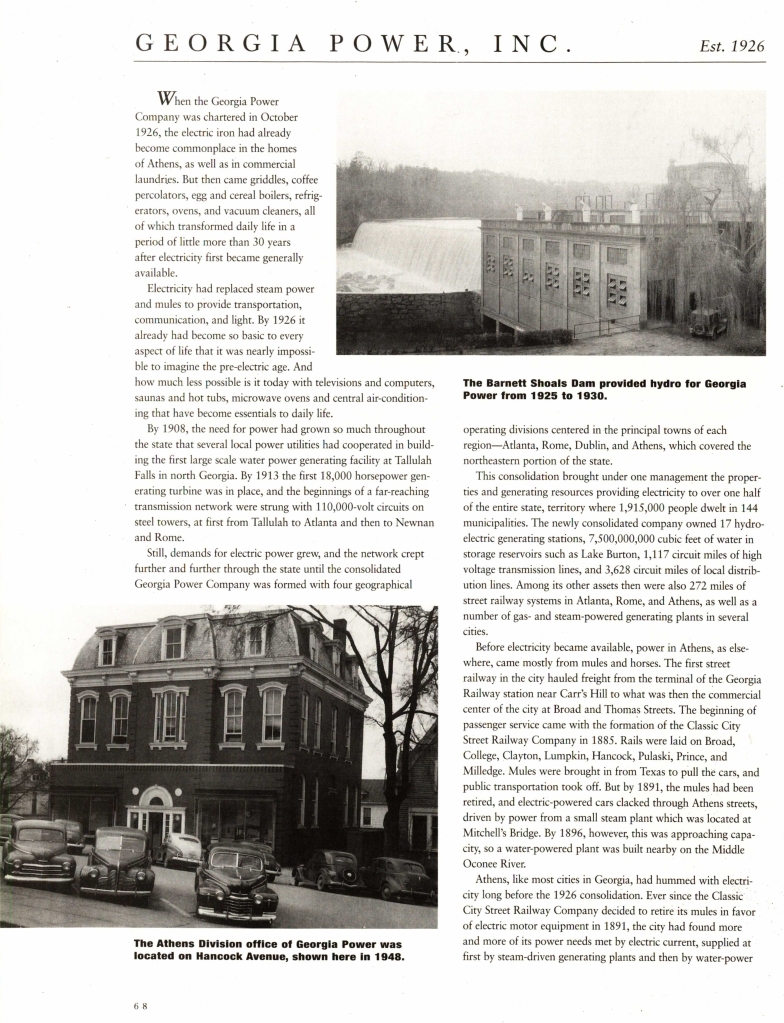The third in our series of articles looking at histories of Athens published for promotional or official purposes takes us, appropriately enough, from the sesquicentennial marked by the previous book, to the city’s bicentennial, occurring conveniently at the dawn of a new century and millennium. In fact, this book, Athens, Georgia: Celebrating 200 Years at the Millennium, was one of several community efforts designed to foster interest in the city’s history in the run-up to the bicentennial. Organized by the Athens-Clarke Heritage Foundation (now known as Historic Athens) in 1999, it was largely written by none other than Conoly and Al Hester, the married couple who did more than most in documenting Athens history, Conoly as a longtime journalist and Hester writing local histories after his retirement from the University, where he had taught for decades at the Journalism school. Conoly wrote the general history that runs through the book, while Al wrote the interspersed profiles of local businesses. In addition to copious historic photographs, the book also features new shots showing Athens as it looked at the time, taken by the esteemed Terry Allen.
An excerpt from Conoly Hester’s general history appears on the two-page spread copied below, in addition to captioned images depicting painter Stan Mullins’ studio and the University’s Department of Dance.


Below is single page from one of the business profiles, of Georgia Power, noteworthy for its views of the Barnett Shoals Dam and the company’s old downtown Athens office.

This long-since-demolished building, as we can see here, is truly a lost architectural treasure, one of those buildings that we wish somehow could have won its battle with the wrecking ball.

Turning to the contemporary photographs by Allen, this view of College Square shows Blue Sky Coffee, Rage Hair Studio, and other businesses, in addition to what is now a rare sight: people hanging out, talking and reading, without tiny computers affixed to their person. Indeed, the area in front of Blue Sky in these years served as a popular meeting place for students, professionals—and everyone in between.

Another Allen photo shows Alex Cook at work on the mural on the back wall of the building at the corner of Broad and Jackson streets that became, in 1999, home to a new music venue, Tasty World. Closing in 2008, Tasty World’s near-decade of offering diverse talent won it a place alongside the 40 Watt Club and the Caledonia as a hot spot for up-and-coming music artists. In its later years, it expanded to include a second-floor space. The venue’s location right where the University meets downtown gave the local music scene a continued presence on the eastern/ southern part of the downtown commercial district. Since its closure nearly all live music has instead been found in the northwestern part, especially on and around West Washington Street.

Speaking of which, we cannot resist including one more brilliant shot by Allen, depicting the now-legendary outdoor Widespread Panic concert of 1998. Flagpole columnist Gordon Lamb’s recent book about the event, Widespread Panic in the Streets of Athens, Georgia, is available at the Athens-Clarke County Library in both the Heritage Room and the regular non-fiction section and is highly recommended. This concert was unique in many ways, unlikely to be repeated, though it did inspire AthFest to set up its concert stage at the western edge of Washington, that festival of local music having originally been held at the other end of the street.
If you view the image at its full size (right-click in Windows, Control-click in Apple) you will see a few signs of businesses no longer extant. One is Marrakech Express, located in what is now the Clocked! American Diner. Another is the original location of Jittery Joe’s, indicated by the large sign bearing the illustration of a coffee cup.
All this talk of the music scene, however, may give a misleading impression of this book’s broad scope. It is certainly meant for a general audience and may perhaps be most noteworthy for the business profiles written by Al Hester. Many of these companies, schools, hospitals, and other entities are not well documented, at least not in the form of publicly-available resources. Those interested in business history may not be aware of the wealth of information to be found here, a clear reminder that researchers always need to check general histories of the city, state, or country that they’re studying, not to mention books narrower in scope but which may touch upon other, related subjects. Most books published in the twentieth century have not been scanned and thus are not full-text searchable. A keyword search at Google Books for these business names, for example, will not turn up any results from this book. In other words, browse the shelves and check the indexes.
To aid the research process, here we supply a handy list of all of the enterprises profiled by Al Hester, in the order in which they appear in the book:
the University of Georgia;
the Athens Area Chamber of Commerce;
the Athens-Clarke County Unified Government;
the Southern Mutual Insurance Company;
the Athens Hardware Company;
Suntrust Bank;
the Athens Marble and Granite and Master Grave Service;
Stiles Properties;
the Athens Regional Medical Center;
Georgia Power;
the Bank of America;
the First American Bank and Trust;
the Athens First Bank and Trust Company (now part of Synovus);
the University of Georgia Athletic Association;
the Varsity;
St. Mary’s Health Care System;
the Clarke Broadcasting Corporation;
Truett-McConnell College;
the Guest Printing Company;
the Athens-Clarke Heritage Foundation;
Exploration Resources;
the Oliver Rubber Company (no longer based in Athens);
the Fowler Products Company (now Fowler Office Interiors);
the ABB Power T & D Company (now Power Partners);
Gold Kist;
Collins, Wilder & Moody (now Collins/ Moody and Company);
Hawthorne Orthopedics;
the Classic Center;
Conwed Plastics;
the McLane Company;
the Georgia Square Mall;
Noramco;
Flower, Inc., Balloons (now Burton and Burton);
Seaboard Farms;
White Cap (now Silgan White Cap America).
–Justin J. Kau

